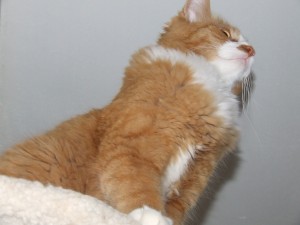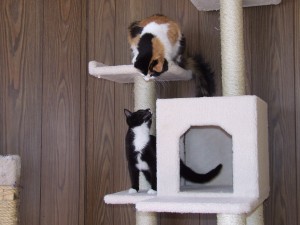Written by Laurie Goldstein, October 2013, updated February 2014
Thanks in large part to the efforts of Ingrid King of The Conscious Cat, the idea that it is “normal” for cats to vomit hairballs has been viewed with ever-increasing skepticism. In her first discussion on this subject, a 2010 guest post by Fern Crist, DVM, “Some Startling New Thoughts on Cats and Hairballs,” the likelihood that hairballs are an early symptom of Inflammatory Bowel Disease was broached, “Impaired motility of the gut would account for the balling up of hair that should pass right through, if stomach-emptying time is the 0.2 – 2 hours it is reported to be in a normal cat. A cat shouldn’t be able to swallow enough hair fast enough to outrace normal stomach emptying time.”
 In fact, a 2013 report published in the Journal of the American Veterinary Medical Association, Diagnosis of chronic small bowel disease in cats: 100 cases (2008–2012) indicated “The most important finding in the study reported here was that signs of CSBD [chronic small bowel disease], including seemingly innocuous vomiting, should not be ignored or considered normal, regardless of the perceptions of owners. More than one-fourth of the 100 cats that met the criteria for this study had clinical signs that were detected during wellness examinations. Signs, especially chronic vomiting, of small bowel conditions in these cats were not considered abnormal or were deemed unimportant by owners….” (emphasis added).
In fact, a 2013 report published in the Journal of the American Veterinary Medical Association, Diagnosis of chronic small bowel disease in cats: 100 cases (2008–2012) indicated “The most important finding in the study reported here was that signs of CSBD [chronic small bowel disease], including seemingly innocuous vomiting, should not be ignored or considered normal, regardless of the perceptions of owners. More than one-fourth of the 100 cats that met the criteria for this study had clinical signs that were detected during wellness examinations. Signs, especially chronic vomiting, of small bowel conditions in these cats were not considered abnormal or were deemed unimportant by owners….” (emphasis added).
The study authors feel “Vomiting of hair balls can be a physiologic response to swallowing hair. However, vomiting > 2 times/mo justifies an ultrasonographic examination for the detection of small bowel thickening. It is suspected that hypomotility of the small bowel as a result of CSBD will prevent proper movement of hair through the bowel and thus predispose to hair ball formation.” (1) In discussion of the work, Dr. Norsworthy, one of the study authors, elaborated: “I am convinced that the vomiting of hairballs is a sign of chronic small bowel disease if it occurs twice a month or more in any cat; or if it occurs once every two months or more in shorthaired cats; or if it occurs in cats that are not fastidious groomers, i.e., presented with many mats in their hair coats or with heavy dandruff.” (2) (emphasis added).
Of course, at CatCentric, we agree with the final assessment in The Conscious Cat’s blog post: species-inappropriate feeding is the root of hairball problems. And for many cats, simply making the transition to raw feeding resolves the issue. Those are the lucky ones, the kitties whose gastrointestinal (GI) systems were not damaged by their time on unhealthy commercial foods. For some, however, the switch to raw uncovers GI damage, and resolving serious hairball problems can be a challenge during the transition. For many of these cat, time and a sustained healthy diet is all that’s needed for the GI tract to heal. For others, however, life-long hairball prevention support may be needed.
Sadly, traditional hairball treatments leave a lot to be desired. Most contain petroleum jelly, mineral oil, a source of fiber or some mix of the three. Obviously, if we’re committed to feeding our cats raw food, we want a healthy, species-appropriate solution! And it DOES exist: egg yolks and egg yolk lecithin.
Why Do Egg Yolks and (Egg Yolk) Lecithin Help Resolve and Prevent Hairballs?
Egg yolks provide many nutritional benefits, but what concerns us here are the micronutrients choline and lecithin.
 Choline: A component of choline is acetylcholine. Acetylcholine acts as a major neurotransmitter for the autonomic nervous system (which includes the GI tract). The stomach and the intestines contain a muscular layer that allows for wave-like contraction of the organs, known as peristalsis. This process propels food through the digest tract. The National Digestive Diseases Information Clearinghouse states that acetylcholine increases the contractions seen in the muscular layer, thus improving peristalsis and pushing food efficiently through the digestive tract. Choline (and its component acetylcholine) improve GI motility, which is what propels hair through so it comes out the proper end.
Choline: A component of choline is acetylcholine. Acetylcholine acts as a major neurotransmitter for the autonomic nervous system (which includes the GI tract). The stomach and the intestines contain a muscular layer that allows for wave-like contraction of the organs, known as peristalsis. This process propels food through the digest tract. The National Digestive Diseases Information Clearinghouse states that acetylcholine increases the contractions seen in the muscular layer, thus improving peristalsis and pushing food efficiently through the digestive tract. Choline (and its component acetylcholine) improve GI motility, which is what propels hair through so it comes out the proper end.
Lecithin: Fat is what binds the hair in the stomach, creating that sticky, often stinky, gooey mess that is a hairball. Lecithin is a fat emulsifier: it emulsifies the fat binding the hairball(s), enabling kitty to pass the ingested hair.
When and How to Use Eggs Yolks and (Egg Yolk) Lecithin
To prevent hairballs, for many kitties, the use of egg yolks (one or two a week) alone will be sufficient.
To resolve hairballs, and for kitties with more difficult hairball problems, an egg yolk lecithin supplement may be needed. If using an egg yolk lecithin supplement, start small and increase as needed. Start with ½ capsule sprinkled onto food every other day. Keep an eye on the litter box: some cats may develop diarrhea before a completely effective dose is reached. The effective maintenance dose needed during shedding season will be higher than in fall and winter. For this author, 2 full capsules daily were needed for her kitties with the worst hairball problems during shedding season. The “difficult hairball kitties” in our home require only ½ capsule daily off-season. (A note of caution: in addition to improving GI motility, acetylcholine also increases GI secretions. This may exacerbate ulcers if your kitty has or is prone to developing them.)
If you have a cat who frequently yacks up hairballs, don’t despair. Along with all the other seemingly miraculous effects of feeding cats the foods they evolved to eat is a healthier, inflammation-free digestive system, and most cats with frequent hairball issues will see those problems abate when switched to their natural, species-appropriate diet. And, thankfully, for those few that may need long-term support for their damaged GI tract, nature has provided the perfect supplement.
References
1. Norsworthy et al. 2013. Diagnosis of chronic small bowel disease in cats: 100 cases (2008-2012); JAVMA 2013;243:1455-1461.
2. Norsworthy, Gary D, 2013. Chronic Vomiting in Cats isn’t Normal After All, Veterinary Practice News, December 30, 2013.
Please also see discussion of the work as written by Dr. Norsworthy: Those frustrating vomiting cats! How our search for the underlying cause of frequent hairballs and vomiting led to what should become a new protocol for all cats with this type of history, DVM360, DVM Newsmagazine, January 1, 2014.
If you enjoyed this article or found it informative, please “Like” it, “Tweet” it, or share it using any of the buttons below. And don’t forget to check out our FB page, join the discussions in our awesome FB group and follow us on Twitter!
Created 12/14/13; Updated 11/01/15

